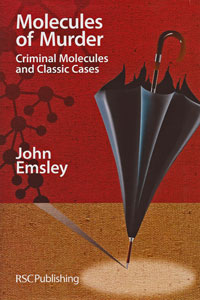Molecules of Murder is about infamous murderers and famous victims; about people like Harold Shipman, Alexander Litvinenko, Adelaide Bartlett, and Georgi Markov. Few books on poisons analyse these crimes from the viewpoint of the poison itself and the forensic evidence. Doing so throws a new light on how the murders, or attempted murders, were carried out and how the perpetrators were brought to justice.
- Published: 2008
- Publisher: Royal Society of Chemistry
- ISBN: 9780854049653 (hbk)
 Did you know?
Did you know?- Why is there an umbrella on the cover of the book? The reason is that this was one of the more unusual methods of putting poison into someone. The victim was Georgi Markov, a Bulgarian dissident who had fled to London and whom the Bulgarian authorities wished to silence because every week he broadcast critical items about them on the propaganda station Radio Free Europe. Markov was stabbed with an airgun disguised as an umbrella when he was waiting for a bus near Waterloo Bridge on his way to work. This shot a poisoned pellet into his leg and three days later he was dead but it took several weeks before it was discovered what had killed him.
Buy Molecules of Murderfrom Amazon.
Table of Contents
- Introduction
- A brief history of the forensic analysis of poisons
- Part I - From medicine to murder
- Ricin and the assassination of Georgi Markov
- Hyoscine and the murder of Belle Elmore
- Atropine and Mrs Agutter's gin and tonic
- Diamorphine and the Dr Jekyll of Hyde
- Adrenaline and the near-perfect murders of Kirsten Gilbert
- Part II - So simple, so useful, so deadly
- Chloroform and the murder of Edwin Bartlett
- Life & Death & CO; Carbon monoxide and the homemade gas chamber
- Cyanide and the death on the Nile
- Paraquat and the poisoned gravy
- Polonium and the poisoning of Alexander Litvinenko
- Glossary
- Further reading
- Index